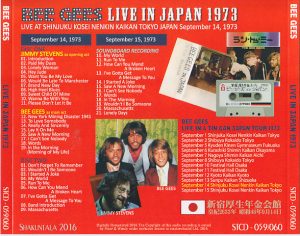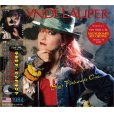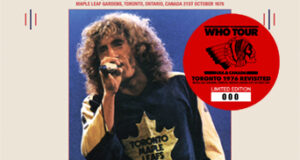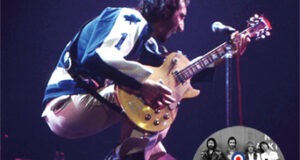Bee Gees / Live In Japan 1973 / 2CD Wx OBI Strip / Shakuntala
Translated Text:
Live At Shinjuku Kosei Nenkin Kaikan Tokyo Japan September 14, 1973. Digitally Remastered
Click Image To Enlarge
The music nature of Bee Gees seems to have affinity with Japanese people. In addition to the gentlemanly appearance from Britain, a number of melodic songs featuring a beautiful chorus would have been easy to recognize even for “adults” who do not accept rock and roll. Its sound image has gained popularity in Japan widely. Of course, the evaluation of Bee Gees is global, but it can be said that it is more than that in Japan in particular. After the “Saturday Night Fever” in 1977, the route changed and I felt that I lost the important “something” of Bee Gees with the higher fame, but as it is their own choice, I must respect as a fan It will not be. There is something in common with the bowie’s dilemma that just released “Let’s Dance”.
Prior to that, Bee Gees had a great influence on Western music other than rock ‘n’ roll and as a chorus group as well as Japan ‘s group sounds. To the Tigers was done until the project to make “Smile For Me” by Bee Gees. Moreover, there is no objection to being the movie “Small Love Melody” that Bee Gees made popularity in Japan secure. This movie is hardly a topic in Europe and the United States, and in spite of being exposed to criticism, especially in home country UK, in exceptional Japan was a huge hit, to those of the generation “this is our movie” It is an important piece of youth that makes me think. And who was singing the theme song of the movie was Bee Gees. The theme song “Melody Fair” of this movie was a big hit in Japan with the hit of the movie, so much that the Minami Saori covered in Japanese. Even now it is often used in commercials and so on, this song that speaks Bee Gees! That is familiar to Japanese fans, that is. However, there is no record that this song hits other than Japan, and it is one of a number of songs that the principals also do not place so much importance, since it is not included in the set list of the Japanese performance described later is there. It feels like a KAN ‘s concert going to “conclude love”, but this also shows that Japan is a special market different from the West and that the Beige’ s musicality is with Japanese fans I think that it is part of proof that affinity exists.
【Japanese performances by Bee Gees】
Bee Gees is one of the groups that has been performing in Japan since early. I came to Japan for the first time in 1972, when I performed a total of 4 Japanese performances at that time. By the way, Kishibe Shirao and Bread & Butter on the undercard. Kishibe Shiro is also singing “around the time of young leaves” even at the stage of the reunion of the 2012 Tigers. The popularity of Bee Gees already in Japan has become certain, and from the number of mobilization and success of the first visit to Japan, from the sales of the record, it will be followed by 1973 and 1974 to Japan for the third consecutive year . It is this work that recorded the second visit to Japan. Not only the major cities such as Tomei Osaka in 1973, the number of performances was increased in all 13 performances, including Kurashiki and Shizuoka. I wonder if they were also surprised that they are popular in Japan, out of the ordinary. This work has recorded Shinjuku welfare pension center performance which became the last place from this second visit to Japan.
【Jimmy · Stevens】
Jimmy Stevens as an undercard for the 1973 tour in Japan. There are 10 songs in all, about 50 minutes on the preliminary stage. Actually, I examined Jimmy Stevens this time, but unfortunately I did not know the details. Originally from Liverpool, England, he released only one album and has since disappeared from major scenes. Its only album “Do not Freak Me Out” was recorded as a luxurious member who participated in the members of Bee Gees, John Bonham on drums, Peter · Frampton on guitar, etc. In musically Gilbert · It draws the flow of O’Sullivan. In this undercard stage, it is mainly performed by one who mainly plays the piano, and in addition to the original song, the Beatles ‘Hey Jude’ etc is played. Apart from whether it was intended or not, it was not interesting for fans who were present at the Shinjuku Welfare Pension Center at that time, with performances and singing that did not feel uncomfortable when aligned with the songs of Bee Gees.
【Bee Gees】
Beigez of this year has been visited Japan for the second time and seems to have a very good time because he experienced warm audiences in Japan in the previous year. At a press conference he joke in a jokes and so on, became. As soon as the Budokan performance of the previous year was broadcasted on television, the fans got big from the airport, and the great welcome mood would have raised their feelings. While it is a hard schedule that all 13 performances will be held throughout the whole country in just half a month, it seems that he was fully enjoying Japan, including going out for sightseeing.
On stage the raw orchestra is waiting for members other than the members of Bee Gees, and now it costed not to be thoughtful. The orchestra that can be heard from the sound source is not a tape but a live performance. The concert opens at the “tragedy of the New York coal mine” by the magnificent orchestra. September 1 except for the addition of “Living in Chicago” only for Barry’s birthday, the set list was common to all performances. The audience listens quietly to a number of beautiful songs to be played one after the other, and is also giving a warm applause.
This work was recorded from the original master who appeared for the first time since it was offered by mania who was at that time at the Shinjuku welfare pension center on September 14, 1973 and has never been around. It can be said that it is a first-class product as a record that it is recorded from the undercard and it is a valuable sound source. Moreover, its sound quality is included, and it is recorded with the mysteriously high-quality quality that I have not been out in the world until now. For a Japanese beacons fan, it will be like a treasure that appeared suddenly before the eyes after more than 40 years since the concert. Unfortunately, it seems that the batteries are exhausted, only Encore ‘s “Lonely Day” is unrecorded in the middle of “Massachusetts”. Although this is a truly regrettable part, it is a part that lacks Ryuugi ‘s point, but even before this sound quality, quality is still such an overwhelming performance and sound quality that I do not care about such things. By all means, I hope that in the Showa 48 visit to Japan, the concert of the Shinjukuku Health Pension Center will be enjoying everything from the undercard with high sound quality.
As a bonus track, the next day of this volume, September 15, 1973 from Shinjuku Welfare Pension Center performance, 12 soundboard sound sources are recorded. Since “Massachusetts” and “Lonely Day” are also completely recorded here, it means that you can listen to the set list at the time in this work perfectly.
【BEE GEES LIVE IN JAPAN 1973】
From the second visit to Bee Gees, September 14, 1973 the Shinjuku Welfare Pension Center performance was recorded from the first high-quality sound master. Next September 15 Shinjuku welfare pension center performance is recorded on the sound board. It is a treasure-like title for the Bee Gees fan, which includes the undercard and reproduces this year’s performance in Japan. It will also be a valuable record in Japan’s overseas artist’s visit to Japan. Permanent preservation of a beautiful picture / disk specification A tightly pressed press. Japanese style attaching.
ビージーズの音楽性は日本人と親和性があるように思える。英国出身の紳士然とした容姿に加え、美しいコーラスを特長としたメロディアスな楽曲の数々は、ロックンロールを受け入れない「大人」でも認めやすいものであったろう。その健全なイメージは幅広く日本で人気を博した。もちろんビージーズの評価は世界的なものであるが、特に日本においてはそれ以上の存在であるといえる。1977年「サタデーナイト・フィーバー」以降は路線が変わり、より高い名声と共に従来のビージーズの大切な「何か」を失った気がするが、それとて本人たちの選択なのだからファンとしては尊重せねばならないだろう。ちょうど「レッツ・ダンス」をリリースしたボウイのジレンマと共通するものがあるのではないか。
それまでのビージーズはロックンロールとは別の洋楽として、またコーラス・グループとして日本のグループサウンズにも多大な影響を与えた存在であった。タイガースに至っては「Smile For Me」をビージーズに作ってもらうという企画まで行なわれた。またビージーズが日本での人気を確実なものにしたのは、映画「小さな恋のメロディ」であることに異論はないだろう。この映画は欧米ではほとんど話題にならず、特に本国英国では酷評にさらされたにも拘わらず、例外的に日本では大ヒットし、その世代の人たちには「これは僕たちの映画だ」と思わせる青春の大切な一作になっている。そしてその映画の主題歌を歌ったのが誰あろうビージーズであった。この映画の主題歌「メロディ・フェア」は映画のヒットと共に日本で大ヒットし、南沙織が日本語でカバーしたほどである。現在でもCMなどで使用されることが多く、ビージーズといえばこの曲!という、日本のファンにとっては馴染みの深いものである。しかし、この曲が日本以外でヒットしたという記録はなく、また本人たちもそれほど重要視していない、数ある曲のひとつなのだろう、なんと後述する日本公演のセットリストには含まれていないのである。まるでKANのコンサートに行って「愛は勝つ」を外されたような気分になるが、これもまた、日本が欧米とは異なる特別な市場であること、そしてビージーズの音楽性が日本のファンと親和性がある証明の一端ではないかと思う。
【ビージーズの日本公演】
ビージーズは早くから来日公演を行なっているグループのひとつである。初来日は1972年で、その時は計4回の日本公演を行なっている。ちなみに前座は岸部シローとブレッド&バター。岸部シローは2012年タイガース再結成のステージでも「若葉の頃」を歌っている。既に日本でのビージーズの人気は確実なものとなっており、初来日の動員数と成功、さらにレコードの売上から、その後も1973年、1974年と3年連続して来日することになる。その2度目の来日公演を収録したのが本作になる。1973年の来日公演は東名阪といった大都市だけでなく、倉敷や静岡などを含む全13公演と各段に公演数が増やされた。本人たちも自分たちが日本で、殊の外、人気があるのに驚いていたのではないだろうか。本作は、この2度目の来日公演より、最終地となった新宿厚生年金会館公演を収録している。
【ジミー・スティーヴンス】
1973年の来日公演は、前座としてジミー・スティーヴンスが帯同している。全10曲、およそ50分の前座ステージである。実は今回、ジミー・スティーヴンスについて調べてみたが、残念ながら詳細はわからなかった。英国リバプール出身で、アルバム1枚のみを発表し、その後はメジャー・シーンから消えている。その唯一のアルバム『Don’t Freak Me Out』はビージーズのメンバーはもとより、ドラムにはジョン・ボーナム、ギターにはピーター・フランプトンなどが参加した豪華メンバーでレコーディングされたもので、音楽的にはギルバート・オサリバンの流れを汲むものである。この前座ステージでは主にピアノの弾き語りを中心としたひとりでの演奏となっており、オリジナル曲の他、ビートルズの「Hey Jude」などを演奏している。意図したかどうか別として、ビージーズの楽曲と並べても違和感のない演奏と歌唱で、当時、新宿厚生年金会館に臨場したファンにとっては興味深いものではなかっただろうか。
【ビージーズ】
この年のビージーズは来日が2度目とあり、前年に日本の暖かい観客を経験しているからか非常に余裕ある様子で、記者会見ではジョークを連発するなど、和やかな雰囲気での来日となった。前年の武道館公演がテレビ放送された直後とあって、空港からファンが大挙するなど、大歓迎ムードも本人たちの気分を高揚させたことだろう。全13公演をわずか半月の間に日本全国で行なうというハード・スケジュールながら、オフには観光に出るなど、充分に日本を満喫していた様子である。
ステージにはビージーズのメンバー以外に生のオーケストラが待機しており、今では考えられないくらい費用のかかったもの。音源から聴くことが出来るオーケストラはテープではなく生演奏なのである。その壮大なオーケストラによる「ニューヨーク炭鉱の悲劇」でコンサートは開幕する。9月1日バリーの誕生日のみ「リビング・イン・シカゴ」が加えられた以外はセットリストは全公演共通であった。次々に演奏される美しい楽曲の数々に聴衆は静かに聴き入り、また暖かい拍手を送っている。
本作は1973年9月14日新宿厚生年金会館に当時臨場したマニア提供による、今まで一切出回っていない初登場のオリジナルのマスターから収録されている。前座から収録されているという記録としても一級品であり貴重な音源であると言える。しかもその音質たるや、今まで世に出ていなかったのが不思議なほど高音質のクオリティで収録されている。まさに日本のビージーズ・ファンにとっては、コンサートから40年以上の時を経て突然に眼前に現れた宝物のようなタイトルであろう。残念ながら電池が消耗したらしく、「マサチューセッツ」の途中からアンコールの「ロンリー・デイ」のみ未収録である。これが本当に残念で画竜点睛を欠く部分なのだが、それでもこの音質、クオリティの前ではそんなことが気にならないくらい圧倒的なパフォーマンスと音質なのである。ぜひ昭和48年ビージーズの来日公演、新宿厚生年金会館のコンサートを高音質で前座から全てを楽しんで欲しいと思う。
なお、ボーナストラックとして、本編の翌日、1973年9月15日新宿厚生年金会館公演より、12曲のみながらサウンドボード音源を収録している。こちらには「マサチューセッツ」と「ロンリー・デイ」も完全に収録されているので、本作で当時のセットリストを完全に聴くことが出来るということになる。
【BEE GEES LIVE IN JAPAN 1973】
ビージーズ2度目の来日より、1973年9月14日新宿厚生年金会館公演を、初登場の高音質マスターより収録。翌9月15日新宿厚生年金会館公演をサウンドボードで収録。前座を含みこの年の来日公演を再現してくれるビージーズ・ファンにとっては宝物のようなタイトル。また日本の海外アーティスト来日史においても、貴重な記録となるであろう。美しいピクチャー・ディスク仕様の永久保存がっちりプレス盤。日本語帯付。
LIVE AT SHINJUKU KOSEI NENKIN KAIKAN TOKYO JAPAN September 14, 1973
DISC ONE
JIMMY STEVENS as opening act
01. Introduction
02. Paid My Dues
03. Lonely Woman
04. Hey Jude
05. Want You Be My Love
06. Would Be Late To Manchester
07. Brand New Day
08. Mighty Blues
09. Sweet Child Of Mine
10. Wanna Be With You
11. Please Don’t Let It Be
BEE GEES as main act
12. New York Mining Disaster 1941
13. To Love Somebody
14. Really And Sincerely
15. Lay It On Me
16. Saw A New Morning
17. I Can’t See Nobody
18. Words
19. In the Morning (Morning of My Life)
DISC TWO
01. Don’t Forget To Remember
02. Wouldn’t I Be Someone
03. I Started A Joke
04. My World
05. Run To Me
06. How Can You Mend A Broken Heart
07. I’ve Gotta Get A Message To You
08. Band Introduction
09. Massachusetts
LIVE AT SHINJUKU KOSEI NENKIN KAIKAN TOKYO JAPAN September 15, 1973
SOUNDBOARD RECORDING
10. My World
11. Run To Me
12. How Can You Mend A Broken Heart
13. I’ve Gotta Get A Message To You
14. I Started A Joke
15. Saw A New Morning
16. I Can’t See Nobody
17. Words
18. In The Morning
19. Wouldn’t I be someone
20. Massachusetts
21. Lonely days
Shakuntala. STCD-059/60
 GiGinJapan Artwork of Japanese CDs (mostly)
GiGinJapan Artwork of Japanese CDs (mostly) 




